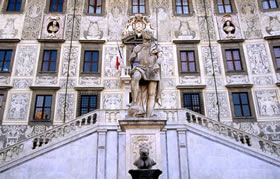Pisa - The Pisa Normale School

The Scuola Normale Superiore of Pisa is one of the most famous and prestigious training and research institutes in Europe. It organizes university courses and research doctorates into two main activities or Classi: arts and philosophy, on one side, mathematical sciences, physics and natural sciences on the other. Its definition "Normale" comes from its main didactic function, namely to convey "norms".
It was born on the 18 October, 1810, by decree of Napoleon as an Italian branch of the Ecole Normale Superieure of Paris.
The Normale of Pisa only started its activity in 1813 and it was destined to the training of high school teachers. Nevertheless, after just one year, Napoleon abdicated and the school was closed.
It was opened again and restarted its activity only in 1846 under Leopold II of Lorraine. In 1862, this school got nationwide recognition and it took the name of "Scuola Normale del Regno d'Italia".
With the publication of the "Annali della Classe di Scienze" and of the "Annali della Classe di Lettere e Filosofia" between 1871 and 1873, this school started its fruitful editorial production. During the years, the activity of training of teachers was sided by the activity of preparation of teachers and university researchers.
The Library of the Normale currently contains more than 600000 texts, reviews and various materials at the students' disposal. On the desks of the Scuola some of the most illustrious people of the Italian culture have studied, such as Enrico Fermi and Carlo Rubbia, who were awarded the Noble Prize for physics, and Giosue Carducci, who received the Noble prize for Literature.
Other famous "normalisti" were the poet Giovanni Pascoli, the historian Gioacchino Volpe, the mathematicians Aldo Andreotti and Mario Picone and the current President of the Italian Republic Carlo Azeglio Ciampi.
The university rises in Piazza dei Cavalieri, a square that takes its name from the Cavalieri di Santo Stefano who had their base here. This order was born in 1562 under Pope Pius IV with the main task to tame the raids by the Turks on the Mediterranean. Pisa was chosen as their base because Cosimo I dei Medici, who was the governor of the Tuscan Grand Duchy, wanted to make of the ancient Seaport Republic and of Livorno the core of the Tuscan naval power.
Moreover, after giving the knights the square that had been the political and administrative centre of the independent city of Pisa, the Medici attributed a high symbolic meaning to this event, since the city was subjected to them by that time.
The architect Giorgio Vasari had the duty to carry out the renovation of the square. By 1564, the knights had already taken possession of the room inside the old Palazzo degli Anziani. In 1569 also a statue made by the Francavilla was raised in honour of Cosimo I.
The building soon took the name of Palazzo dei Cavalieri della Carovana and this is where the Scuola Normale has its base today. The creation of a didactical institute inside the Palazzo was a sensible choice.
This building also had the function of a college and a study place for those soldiers who spent here three years of training into the art of warfare and into sciences.
This is testified by the internal layout drawn by Vasari, who wanted the palace to be a sort of college. The architect also worked hardly in redrawing the medieval facade of the palace so as to transform it into the harmonious and geometrical structure that it is possible to admire when going to Piazza dei Cavalieri.